
Topics
Guests
- Bill McKibbenauthor, activist and founder of 350.org His latest book is Eaarth: Making a Life on a Tough New Planet.
- Jean Altomaresenior wildlife major at Unity College in Maine.
A group of Unity College students, led by environmentalist Bill McKibben, set out Tuesday for Washington, DC, carrying a solar panel that once stood atop President Jimmy Carter’s White House. In 1979, Carter installed solar panels on the roof of the West Wing as part of a new solar strategy. They were removed by President Ronald Reagan in 1986 and put into storage. In 1990, the panels were brought to Unity College in Maine. The students are now hoping to convince President Obama to reinstall the panel back on the White House roof. [includes rush transcript]
Transcript
AMY GOODMAN: We move on to our last segment now, oh, to shed some light — and a little heat — on an issue that’s been going on for quite a number of years. Juan?
JUAN GONZALEZ: Well, thirty-one years ago, President Jimmy Carter stood on the roof of the White House, flanked by reporters, to make an unusual announcement. He was installing thirty-two solar panels on the roof of the West Wing.
PRESIDENT JIMMY CARTER: In the year 2000, the solar water heater behind me, which is being dedicated today, will still be here, supplying cheap, efficient energy. A generation from now, this solar heater can either be a curiosity, a museum piece, an example of a road not taken, or it can be just a small part of one of the greatest and most exciting adventures ever undertaken by the American people.
JUAN GONZALEZ: The solar panels were used to heat water in the White House and were a symbol of President Carter’s new solar strategy. But the strategy did not last for long. In 1986, President Ronald Reagan took the solar panels down when the White House roof was being repaired. They were never reinstalled. In 1990, the panels were retrieved from government storage and brought to Unity College in Maine.
AMY GOODMAN: Well, on Tuesday, a group of students took one of the panels, packed it onto a biodiesel van, and set out on a trip to Washington. They’re hoping to convince President Obama to accept the 1979 relic and install a new set of solar panels on the White House roof. The students were joined by renowned author and environmental activist Bill McKibben.
The van has just arrived in New York, and the group is joining us now in the studio. Bill McKibben is with us, author, activist, founder of 350.org. And Jean Altomare is a senior wildlife major at Unity College in Maine. And the solar panel is also here in the studio with us, along with other Unity College students.
We welcome you all to Democracy Now! Jean, why don’t you shed some light on the subject? What are you doing?
JEAN ALTOMARE: Well, we’ve seen these panels on the roof of the cafeteria our entire time at the college, and they’ve just been there. We completely forgot the story they had. So we’re remembering the story, and we’re bringing them back to the White House, trying to garner support for a new system of photovoltaics on the roof.
JUAN GONZALEZ: Did you have much difficulty getting the college to allow you to take one down?
JEAN ALTOMARE: Well, there are sixteen on the roof of the cafeteria, and we have more than that in storage. So there were plenty. I don’t actually know this one was removed from the roof, but we actually had Unity kids restore it.
AMY GOODMAN: So, Bill McKibben, talk about what Carter did, what Reagan did, and what you’re hoping Obama will do.
BILL McKIBBEN: The tragedy of this thing is that we knew thirty-one years ago how to do this stuff, OK? This panel still works fine. We made hot water with it in an hour on the streets of Boston yesterday. It was coming out steaming. We knew how to do this thirty-one years ago. We abandoned it.
Now we’re hoping — you know, frankly, I mean, given the choice, we’d rather have strong climate legislation, but that’s not in the cards right at the moment. It would be a very good symbolic gesture to say, “We’re picking up where we left off thirty-one years ago. At the most visible piece of real estate in the United States, we’re going to make it clear that we’re committed to renewable energy.”
JUAN GONZALEZ: And, of course, the irony of Jimmy Carter starting this so long ago, and all the other presidents basically paying lip service to the issue of solar energy?
BILL McKIBBEN: Talk about irony. You know where one of these other panels is? It’s in the private museum of the Chinese entrepreneur who’s built the world’s largest solar thermal company on earth on to earn your who built the world’s largest solar thermal company on earth, Himin Solar. They’ve installed 60 million arrays like this across China. When hundreds of millions of Chinese take a shower in the evening, it’s with hot water that’s been made on the roof. We owned this industry thirty years ago; now we’re not even a player. It’s time to get back to it, in part because if you’re looking for jobs, which theoretically we all are right now, you know, it’s pretty hard to think of anything that’s going to create more than putting solar panels on roofs across America.
AMY GOODMAN: One of the things President Obama has been slammed on by various people in the media is he got distracted from the economy by talking about issues like cap and trade and environmental legislation.
BILL McKIBBEN: He’s been distracted by a lot of things, and it’s been — you know, I mean, who would want his job? It’s hard. One of the things that we’re sort of trying to do is offer them a little — a little happy news, you know? Remember when Michelle put the garden in the White House lawn, it was a moment of good feeling, and it spiked seed sales around the country 30 percent the next year. The good thing about this is, you don’t — I mean, the Republicans can’t filibuster the roof, you know? You don’t need sixty votes to put this thing up. All you need to do is get up there with a — we’ve found the plumbers and electricians, the union guys who want to do this. There are companies across America, who are led a group called Sungevity in California, that are eager to donate the panels. It’ll be a win-win for the taxpayers, because we won’t be having to buy electricity to heat the President’s shower anymore. All to the good.
AMY GOODMAN: Are there any signals from the White House?
BILL McKIBBEN: We’re headed down there today, and we’ve been talking with them. I don’t think they’re going to say, “We’re putting the panels on the roof.” We hope that they’ll say, “We’re going to take a good hard look at it.” Let’s hope.
JUAN GONZALEZ: But, of course, the White House can afford to install the panels, if they so decide. But many Americans in existing homes might say, “Hey, for us to bring solar panels onto an old house is a very prohibitively expensive situation right now.”
BILL McKIBBEN: That’s a very good point, Juan. The good thing about this kind of — one of the points we’re trying to make is that this solar hot water technology, the kind of older and less glamorous form of solar, as opposed to photovoltaic, it has a terrific payback time. It’s cheap and easy to do. It’s one of the reasons why it’s important to get it up on the White House.
But you’re right. Look, I mean, what we need is big, large-scale legislation that changes the way we use energy in this country. My guess is we’re not going to get it for the next couple of years. We failed this year. The climate bill died in the Senate. They preserved their perfect twenty-year bipartisan record of accomplishing nothing. We got to get moving somehow. This is one small way.
AMY GOODMAN: What’s happening leading into Cancún? We’re almost a year now after the Copenhagen climate summit that the US led in failure, unfortunately.
BILL McKIBBEN: I’m afraid that Cancún is going to be tough also. Without some leadership from the US Congress, it’s an awful lot to ask the other countries of the world to do very much. Frankly, what I’ve been saying is, I think the next couple of years, in this country and internationally, have got to be a time most of all for movement building, for building a force strong enough that the next time there’s a political opening or that the natural world provides one, that we’re able to enact real, tough, meaningful legislation.
AMY GOODMAN: Jean, what are all these signatures on this solar panel that stands — what, is it about six, seven feet tall?
JEAN ALTOMARE: Every signature on that is someone who has stopped in, talked to us, heard what we have to say, and then signed, just signifying that they absolutely support this technology once again being on the roof of the White House and actually being prevalent as a form of power in America.
AMY GOODMAN: And what does 350.org stand for?
JEAN ALTOMARE: Three-fifty is the — it’s the number parts per million carbon molecules in the atmosphere that allows for human and all life on earth to continue as we know it. Currently we’re at 392, so the backwards era when the three indicates that we definitely need to move that number down. And fairly fast, actually.
JUAN GONZALEZ: And when you finish school, what are you hoping to do with yourself?
JEAN ALTOMARE: Up until about two days ago, I wanted to be a naturalist. I feel maybe I’m going in a different direction now.
AMY GOODMAN: Which is what?
JEAN ALTOMARE: Environmental activism.
AMY GOODMAN: Well, I want to thank you all for coming in. Good luck on your trip to Washington, DC.
JEAN ALTOMARE: Thank you.
AMY GOODMAN: Jean Altomare is a senior wildlife major at Unity College in Maine. Bill McKibben, author, activist, founder of 350.org. And we’ll let people know what happens when you hit DC.


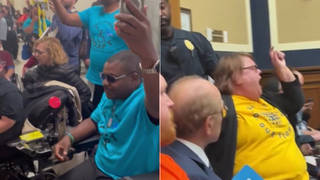
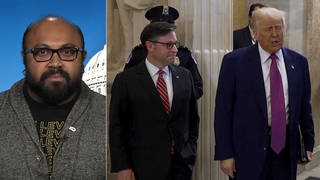
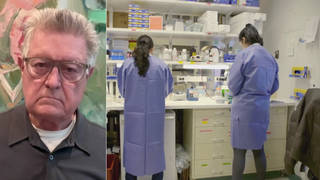
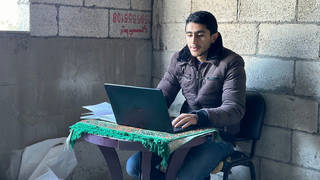
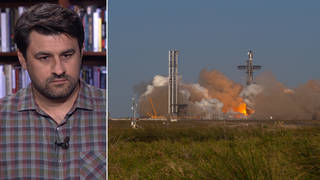
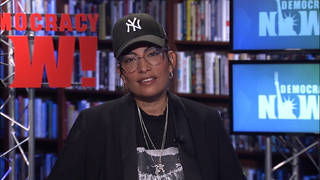
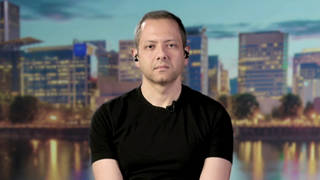

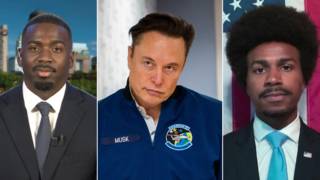

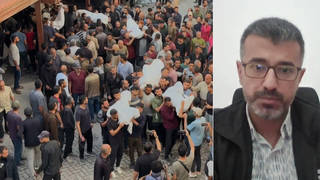
Media Options